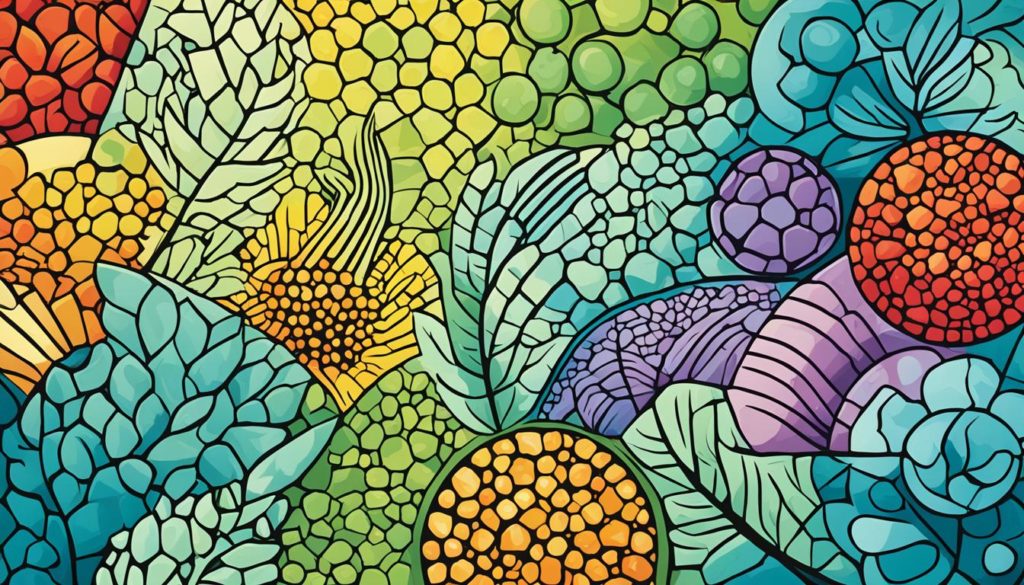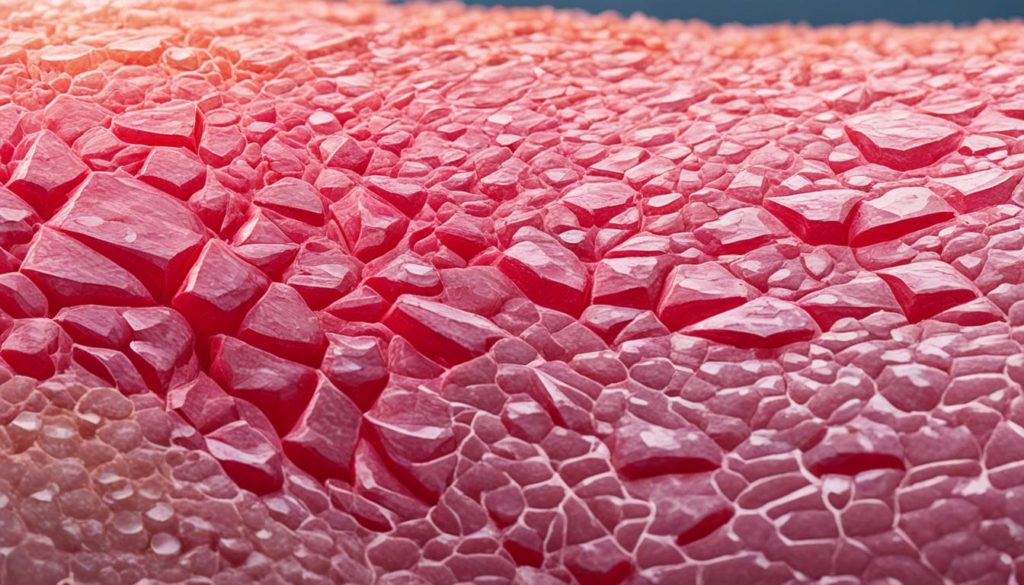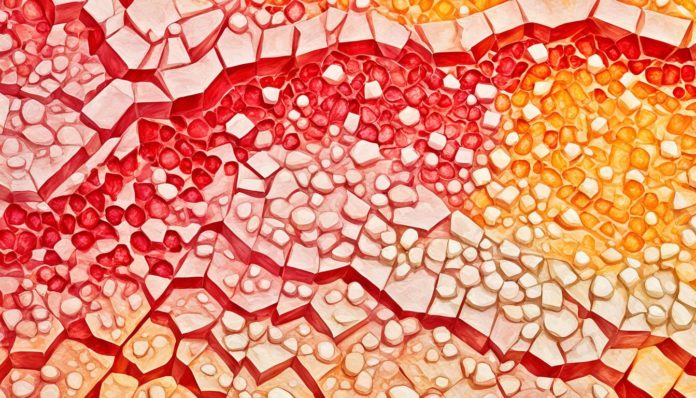Did you know over 31.6 million Americans suffer from some type of eczema, including dermatitis? This condition leads to chronic skin inflammation. Nearly 10% of people in the U.S. are affected, highlighting its importance for both patients and doctors.
Dermatitis causes long-lasting skin inflammation that can really affect someone’s life. This article dives into dermatitis, looking at causes and types. You’ll also discover the various symptoms and the many ways to treat them.
Key Takeaways
- Dermatitis affects approximately 31.6 million Americans.
- The condition is characterized by chronic skin inflammation.
- Understanding the causes and symptoms is essential for management.
- A variety of treatment options exist, both topical and lifestyle-based.
- Effective management can significantly improve quality of life.
Introduction to Dermatitis
Dermatitis is a general term for skin inflammation. It comes in different forms and affects many people worldwide. It’s key to understand dermatitis to manage and treat it well. The causes range from genes to environmental factors. This can lead from slight irritation to serious inflammation.

What is Dermatitis?
Dermatitis is actually many conditions that make the skin red, itchy, and sometimes swollen. It’s a lasting issue that can disrupt daily life. Causes include allergens, irritants, and stress. Managing it requires a broad approach.
Common Types of Dermatitis
There are several main types of dermatitis, each with its own features and reasons. Here are the key ones:
- Atopic Dermatitis: Also known as eczema, this chronic skin issue causes dryness and itchiness. It usually starts in childhood and may continue into adulthood. It often comes from genetics and an overly active immune system.
- Contact Dermatitis: This happens when skin touches something that irritates it or causes an allergy. Things like soaps, detergents, and jewelry are common culprits.
- Seborrheic Dermatitis: This is found where the skin has lots of oil glands, like the scalp and face. A yeast that lives on our skin, Malassezia, relates to it.
Knowing these types is the first step in treating and managing the condition. We’ll explore treatment and management next.
Symptoms of Dermatitis
It’s important to know the symptoms of dermatitis early. Dermatitis, including eczema, shows up with clear signs on the skin. Knowing these signs helps to recognize the condition and get the right treatment.
Visible Signs on the Skin
Dermatitis mainly shows as a skin rash, with red and swollen skin. The skin can turn dry, scaly, or flaky. When scratched, the skin might ooze or form crusts, especially if infected. Itching, which often makes things more uncomfortable, is another common sign.
Common Areas Affected
Dermatitis often appears in certain body parts:
- Elbows and knees, due to irritation in the bends.
- The face, like cheeks and forehead, gets red and dry.
- The scalp, with itchy, scaly patches.
- Hands and feet might crack or blister.

Knowing these common areas helps in spotting dermatitis early for better management.
When to See a Doctor
Sometimes, home treatments for dermatitis aren’t enough. You should see a doctor if:
- The skin rash is bad or spread over a big area.
- You see signs of infection, like pus, more redness, or swelling.
- Your symptoms don’t get better with home care or they get worse.
- You’re in a lot of pain or can’t do your daily activities.
Seeing a doctor early can stop the condition from getting worse and help you follow the best treatment plan.
Causes of Dermatitis
It’s key to know the different things that can trigger dermatitis to handle and prevent it well. Dermatitis may be linked to many causes of skin irritation. This includes things you’re born with and things around you. Everyone faces dermatitis differently because of these varied causes.
Having family members with dermatitis can make you more likely to get it, too. This link often comes from changes in the genes that help protect our skin and control inflammation.
Environmental factors are big in setting off dermatitis. Things like chemicals in cleaning products, soaps, and detergents are common culprits. Also, allergens like pollen, dust mites, and pet fur can make skin issues worse.
Choices we make every day and even our jobs can impact our risk of dermatitis. Washing hands too much, using strong chemicals, and stress are all things that can trigger skin problems. The mix of our body’s natural traits and our environment makes dermatitis challenging to manage.
Let’s compare some internal and external things that can cause dermatitis:
| Internal Factors | External Factors |
|---|---|
| Genetic predisposition | Contact with allergens |
| Immune system irregularities | Exposure to irritants |
| Stress and emotional factors | Climate and weather conditions |
| Hormonal changes | Occupational hazards |
Atopic Dermatitis
Atopic dermatitis, often called eczema, is a common, long-lasting skin issue, especially in kids. It’s closely linked to the immune system and is one part of the atopic triad. This triad also features asthma and hay fever.
An Overview of Atopic Dermatitis
Atopic dermatitis means having swollen, dry, and itchy skin. This can lead to a lot of discomfort and stress because of the constant itch. The immune system reacting too strongly to certain triggers plays a big role in making this condition worse.
Symptoms of Atopic Dermatitis
The main signs of atopic dermatitis are itchy skin, red or brown patches, and small bumps that might leak fluid if scratched. These usually show up on the face, neck, hands, and the elbows and knees’ bends.
Triggers for Atopic Dermatitis
Different things can set off or worsen atopic dermatitis. Stress, changes in the weather, rough fabrics like wool or synthetics, and some soaps and detergents are common triggers. Knowing what triggers your symptoms is key to managing them well.
| Trigger | Impact on Eczema |
|---|---|
| Stress | Can make symptoms worse due to its impact on the immune system. |
| Weather Changes | Very cold or very hot weather can worsen skin conditions. |
| Certain Fabrics | Wool and synthetic fabrics can irritate the skin. |
| Soaps and Detergents | Strong chemicals can remove natural oils, causing dryness and irritation. |
To manage it well, find out what triggers your eczema and keep away from them when you can. Also, choose the right treatments to lessen symptoms and make life better.
Contact Dermatitis
Contact dermatitis occurs when skin reacts to certain substances. It divides into allergic contact dermatitis and irritant contact dermatitis. Knowing the difference helps manage the condition.
Types of Contact Dermatitis
Allergic contact dermatitis happens when your body reacts to allergens like nickel, latex, or scents. The body sees these as threats, causing an allergic response. Irritant contact dermatitis occurs when skin is damaged by things like soaps or water exposure.
Common Irritants and Allergens
Knowing common triggers is key to prevent contact dermatitis. Some common sources include:
- Nickel: It’s in many metal items like jewelry.
- Fragrances: Found in beauty products and soaps.
- Detergents: In cleaners around the house.
- Solvents: In heavy-duty cleaners and some paints.
- Latex: In some clothing and rubber gloves.
Managing Contact Dermatitis
Handling contact dermatitis starts with avoiding triggers. Skin tests can find specific allergies. Barrier creams protect while moisturizers keep skin healthy. Sometimes, creams or antihistamines are needed for bad reactions.
Good avoidance and care methods make managing both types of contact dermatitis possible. This reduces outbreaks, improving life quality.
Seborrheic Dermatitis
Seborrheic dermatitis is a long-lasting skin condition. It causes red, itchy areas with flaky scales. It often looks like dandruff on the scalp. Understanding its causes and treatments is key to managing it.
Causes of Seborrheic Dermatitis
The true causes of seborrheic dermatitis are still being studied. However, Malassezia yeast is a known factor. This yeast loves oily skin. Stress, hormone changes, and harsh weather also play a role in causing it.
Seborrheic dermatitis can also be influenced by an individual’s genetic predisposition, making some people more susceptible to the condition than others.
Treatment Options
To treat seborrheic dermatitis, doctors often recommend special shampoos and creams. Products with ketoconazole or selenium sulfide are popular. They help reduce dandruff and soothe the skin. In tough cases, you might need stronger prescription medicines.
Making lifestyle changes can help too. Washing your scalp regularly, reducing stress, and eating well can make a difference. These steps improve skin health.
| Treatment Type | Examples | Effectiveness |
|---|---|---|
| Medicated Shampoos | Ketoconazole, Selenium Sulfide | High |
| Prescription Treatments | Corticosteroids, Calcineurin Inhibitors | Very High |
| Lifestyle Adjustments | Regular Cleansing, Stress Management | Moderate to High |
Treatment for Dermatitis
Managing dermatitis means finding what works best for you. Treatment varies based on the dermatitis type and triggers. This includes both medical treatments and natural ways to ease symptoms and prevent more issues.
Doctors often prescribe medications for treatment. These include creams and pills to reduce inflammation and heal the skin. For example, corticosteroids and calcineurin inhibitors help with swelling and itchiness in eczema. Antihistamines and antibiotics are used for infections and allergies.
On the holistic side, taking care of your skin is key. This means moisturizing often, avoiding irritants, and reducing stress. Natural remedies like aloe vera, coconut oil, and oatmeal baths are beneficial too. They soothe and help heal the skin.
Let’s look at the best medical and holistic treatments for dermatitis:
| Treatment | Description | Effects |
|---|---|---|
| Topical Corticosteroids | Medications applied directly to the skin to reduce inflammation | Quick relief of swelling and itchiness |
| Calcineurin Inhibitors | Non-steroidal topical treatments to reduce immune response | Effective for sensitive skin areas like the face |
| Moisturizers | Products designed to hydrate and protect the skin barrier | Long-lasting hydration and prevention of dryness |
| Dietary Changes | Eliminating food triggers and incorporating anti-inflammatory foods | Potential reduction in flare-ups and systemic inflammation |
| Natural Remedies | Using natural substances like aloe vera and coconut oil for soothing | Provides calming effects and aids in skin healing |
A good plan for managing dermatitis often mixes medical treatments with natural care. Customizing the approach to fit the person’s lifestyle and needs helps keep symptoms under control over the long term.
Topical Treatments
Treating dermatitis starts with topical treatments to ease symptoms and heal. We’ll look at from simple store-bought solutions to prescribed remedies. You’ll also learn how to use them correctly.
Over-the-Counter Creams and Ointments
For light dermatitis, many over-the-counter options help. They include moisturizers to keep the skin hydrated and improve the skin barrier. Hydrocortisone creams are popular for reducing redness and itch. Ingredients like ceramides and colloidal oatmeal in these products also help soothe and fix damaged skin.
Prescription Treatments
When basic items don’t work, doctors may suggest stronger creams like corticosteroids. These creams quickly lower inflammation and make the skin barrier healthier. There are also special creams like tacrolimus and pimecrolimus for tough cases. They change the skin’s immune response to ease symptoms.
How to Apply Topical Treatments
Using treatments correctly is key to their success. Here are important steps:
- Cleanse the affected area: Gently wash with a mild, fragrance-free cleanser to remove any dirt or irritants.
- Pat dry: Use a soft towel to lightly pat the skin dry, avoiding vigorous rubbing that can exacerbate irritation.
- Apply the treatment: Using clean hands, apply a thin layer of the product to the affected area. For corticosteroid creams, be sure to follow your doctor’s instructions regarding the amount and frequency.
- Follow with a moisturizer: Seal in the treatment with a layer of moisturizer to help restore and protect the skin barrier.
- Avoid scratching: To allow the treatment to work effectively, try to avoid scratching, which can worsen the condition and impede healing.
Lifestyle Changes to Manage Dermatitis
Dealing with dermatitis isn’t just about medicine. It includes making lifestyle changes for better skin health and wellness. This involves looking at your diet, how you take care of your skin, and the environment around you.
Diet and Nutrition
An allergen-free diet is key in controlling dermatitis. It reduces inflammation and steers clear of food triggers. Eating foods high in Omega-3s, like salmon and flaxseeds, can cut down skin swelling. Staying away from nuts, dairy, and gluten might also help ease symptoms.
For more on how diet affects dermatitis, check out the Cleveland Clinic’s guide. They have lots of info on managing atopic dermatitis with diet and nutrition.
Skincare Routines
For anyone with dermatitis, a gentle skincare routine is vital. Choosing hypoallergenic products helps avoid irritation. Use products without fragrance or dyes. This helps keep the skin calm. Keeping your skin moisturized is also key in making sure it stays healthy.
Environmental Modifications
What’s around you can really affect your dermatitis. Making some changes at home and work helps lower contact with irritants. Things like air purifiers, controlling humidity, and a clean home can make a big difference. Using allergy-friendly bedding and avoiding harsh chemicals will also help.
Adding these lifestyle adjustments to your routine, along with ways to reduce stress, can make managing dermatitis easier. For more about how changing your surroundings can help, click here.
Preventing Dermatitis Flare-ups
Controlling dermatitis needs a plan focusing on both stopping flare-ups and avoiding triggers. It is very important to have a good skincare routine. This helps reduce how often and how bad the outbreaks are.
One key part of dealing with dermatitis is avoiding things that make it worse. This could be certain clothes, soaps, or things in the environment. Writing down what you come into contact with can help find out what causes your flare-ups. This makes it easier to stay away from these triggers.
- Regularly moisturizing to strengthen the skin barrier.
- Wearing soft, breathable clothing to reduce skin irritation.
- Opting for hypoallergenic skin products to minimize reactions.
- Implementing a gentle skincare routine to avoid aggravating sensitive skin.
Managing stress is also key in preventing dermatitis flare-ups. Using yoga, meditation, and deep-breathing exercises can lower stress. Making these practices a part of your daily life can make a big difference.
| Preventative Measure | Benefits |
|---|---|
| Trigger Avoidance | Reduces likelihood of flare-ups |
| Proactive Skincare | Strengthens skin barrier |
| Stress Management | Minimizes stress-induced reactions |
| Hydration | Keeps skin moisturized and less prone to irritation |
| Avoid Harsh Fabrics | Decreases skin friction and irritation |
Following these steps can make a big difference in controlling dermatitis. This leads to a better life with fewer flare-ups.
Conclusion
Dealing with dermatitis can be tough, but it’s easier if you really understand it. Knowing the causes and signs helps you manage it better. It’s key to know your triggers for atopic, contact, or seborrheic dermatitis.
There are many parts to effective treatment. You might need creams from the store or a doctor’s prescription. Changing your skincare, diet, and environment helps a lot too. These changes can make your skin better and boost your health.
To really handle dermatitis, stay up-to-date on the best care methods. It may be a long-term issue, but you can manage it. By using these tips, you can hope for healthier skin and more comfort in the future.
FAQ
What is dermatitis?
Dermatitis is when skin gets inflamed, causing a lot of redness, itching, and swelling. It can make you feel pretty uncomfortable.
What are the common types of dermatitis?
Atopic dermatitis (eczema), contact dermatitis, and seborrheic dermatitis are types you’ll hear about most. They each have their own causes and ways to make you feel better.
What are the symptoms of dermatitis?
Symptoms include rashes, skin getting dry and red, and really itchy. The skin might also feel hot and look swollen. Sometimes, blisters or crusts can form.
What causes dermatitis?
Genes, things around you like allergens, and what you do can lead to dermatitis. Soaps, detergents, metals, and even stress are common culprits.
How is atopic dermatitis different from other types?
Atopic dermatitis, or eczema, involves your immune system acting up. It’s often found with other allergies, like asthma. It causes chronic itchy rashes.
What are common triggers for atopic dermatitis?
Stress, changing weather, scratchy fabrics, and allergens like pet hair and dust mites can trigger it. Knowing and avoiding these triggers helps a lot.
What is contact dermatitis?
This happens when your skin touches something that irritates it or causes an allergy. It turns red, itchy, and swollen. There are two types: allergic and irritant.
How can contact dermatitis be managed?
Stay away from stuff that irritates your skin. Wear gloves for protection and use creams as your doctor says.
What causes seborrheic dermatitis?
A type of yeast on your skin, stress, hormones, and weather can all play a part. It causes inflammation.
What are the treatment options for seborrheic dermatitis?
Medicines like special shampoos, creams, and changing your routine can help. Managing stress is also key.
How can dermatitis be treated?
There’s a mix of treatments, from simple creams you can buy to prescriptions. Moisturizers and special creams are typical. A skin doctor can offer personalized advice.
What steps can I take to prevent dermatitis flare-ups?
Avoiding triggers, keeping skin care gentle, staying calm, and tweaking your surroundings helps keep it at bay.
When should I see a doctor about dermatitis?
If symptoms are bad, won’t go away, or over-the-counter stuff doesn’t work, see a doctor. They can figure out the best plan for you.


